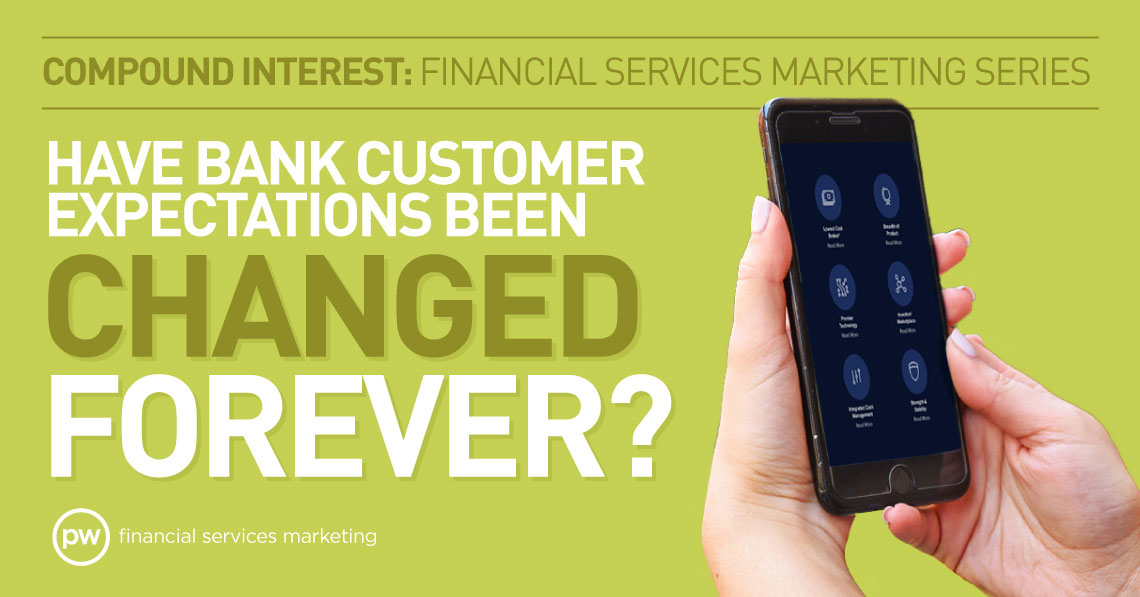There’s no denying that customer experience (CX) has looked very different in 2020. However, there’s still a question of how this strange year might affect expectations for CX moving forward.
How Has 2020 Changed CX?
2020 has been a roller coaster for companies across a wide array of industries, as business leaders have had to grapple with how to make customers and employees feel safe while still delivering a good customer experience and being profitable. Financial institutions have been no exception, as digital tools, reduced lobby hours and increased drive-thru and ATM activity have all been part of the formula. During tumultuous times, people naturally look for security, and knowing that they have access to their finances is one form of comfort that most individuals value. As though the paradigm between safety and access wasn’t difficult enough for financial institutions, many customers’ craving for convenience didn’t subside at all during the crisis. While it could be argued that many businesses experienced grace from their customers in the early goings-on of the pandemic, this grace seemed to dissipate as more and more Americans accepted that the circumstances of the crisis were going to be more of a new normal than a short-term deviation.
The Wheels Were in Motion Before the Pandemic
Forrester conducted research through the great recession that tracked shareholder returns for financial institutions that were CX leaders as well as laggards. CX leaders experienced far fewer detrimental drops in returns during the last recession but also bounced out of the recession in much better shape than laggards. Overall, leaders saw 3x greater cumulative returns to shareholders between 2007 and 2010 than laggards.
According to Forrester CX index, 27% of U.S.-based brands improved their year-over-year score from 2019 to 2020. This jump indicates significant momentum in terms of companies placing more emphasis on CX, considering that a relatively small number of brands increased their YOY score in previous years. It’s important to note though that most of the 2020 data was collected prior to the pandemic.
While it is widely believed that companies who invested heavily in customer experience before and during the pandemic will come out of it stronger than their competitors, it is also likely that these leaders have raised the CX bar for their respective industries. This organic rise in expectations is now compounded by the events of 2020 and now represents a daunting mountain to climb for the CX laggards.
Is the CX Gap Widening?
Due to the increase in companies adopting CX as not just a talking point but a tangible competency that demands investment, the gap between CX leaders and laggards was expanding prior to the pandemic. A recent report from August 2020 by Forrester backs this up by showing substantial lifts in both the number of companies experimenting with CX as well as the number of companies that have mastered it by becoming experts. While long-term return-on-investment studies related to CX have made a compelling argument for why companies should invest in CX, it will be interesting to see what customer experience studies show after the pandemic. The challenges presented to companies in 2020 illuminate their CX capabilities. With so many companies placing increased emphasis on CX right before 2020, the pandemic now creates a bit of a natural experiment to see how those companies will fare from both a revenue perspective and a customer sentiment one. The scarier question though may just be for the companies that chose not to invest heavily in CX, as any lack of capability in the area was likely glaringly obvious to their customer base during the crisis. Playing catch-up to the competition will also now prove extremely difficult in the current climate. Compounding the challenge is the well-adopted theory that good CX requires continual improvement, meaning that the companies that are already doing well have trained themselves to not rest on their laurels. Continual CX optimization was the 3rd key finding in the Forrester study referenced above.
Play Catchup but Test and Optimize While Doing So
The Forrester report referenced above cited increasing operational agility and investing in new technologies such as AI as the two primary recommendations for improving CX moving forward. For financial services providers that don’t fall into the category of industry giant, this will likely mean partnering with third-party providers in the tech space. The challenge in this is not only regulatory compliance but also ironing out any kinks before a full launch. Customers in the financial services space aren’t very forgiving of technical glitches that cause problems relating to the accessing of their accounts. Furthermore, certain sub-segments have negative feelings toward big changes in general. That’s why it will be important for financial institutions to have test runs with smaller segments of their customer base before going mainstream with new tech offerings. Once new offerings are fit for mass use, it may still be wise for institutions to offer such new tools on an opt-in basis rather than requiring customers to use them in the early stages. Many institutions will feel rushed to get new tools to their customers, but it’s important to keep in mind that as important as innovation is, trust still comes first in the financial services space.
Questions?
Whether your company is a CX leader, you feel you are struggling to catch-up or you just have some general interest questions, feel free to contact us here or give us a call at 502-499-4209 to get some time on Jonathan Bone’s schedule.
About the Author
Jonathan Bone is Partner and Senior Vice President at PriceWeber. He is the Account Director in charge of PW Financial Services and oversees all work with Financial Services Clients.


